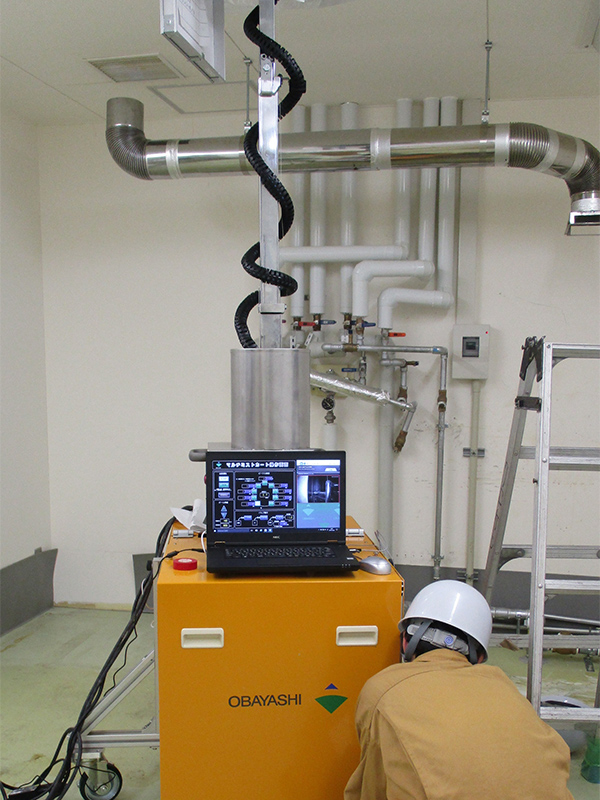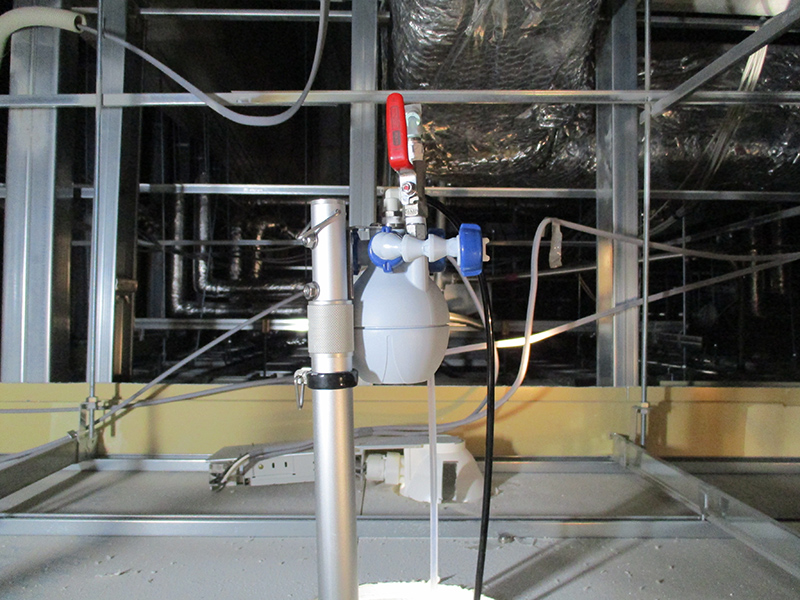- 4 Technology
- Technology Development
Asperbuster: Technology to Prevent Mold Infections in Hospital Renovation and Demolition Work
Obayashi Develops Asperbuster®—Technology That Prevents Mold Infection in Renovation and Demolition Work at Hospitals
Disinfecting with Asperbuster before Starting Construction Work Significantly Reduces the Risk of Spreading Aspergillus
Obayashi Corporation has developed Asperbuster, a technology that is designed to kill Aspergillus quickly and at low cost. Aspergillus grows inside the ceiling and causes mold infection. Asperbuster can be used to kill Aspergillus before a renovation or dismantling work at hospitals. This drastically reduces the risk of Aspergillus spreading to other areas.
Aspergillus is a mold that typically grows in a variety of environments including soil. Aspergillus produces a lot of spores, so they also attach to dust and other particles and float in the air. Aspergillus is virtually harmless to healthy individuals when inhaled. However, it can cause severe pneumonia called aspergillosis if inhaled by immunocompromised individuals.
Renovating or demolishing a building can create a lot of dust. At hospitals where there are many individuals with weakened immunity due to illness or other conditions, it is especially important to take appropriate precautions to prevent patients from developing aspergillosis. Typically, areas that are being renovated or demolished are sealed off, and negative pressure is used to contain dust. However, in recent years, the need to reduce the risk of dispersing dust has become greater in some situations.
In the past, little detail was known about where Aspergillus existed. Obayashi Corporation used DNA analysis technology ahead of competitors to study where Aspergillus existed and discovered that dust accumulated inside the ceiling contains large amounts of Aspergillus. Asperbuster is the first technology in the industry that is designed to prevent aspergillosis. Asperbuster is used to kill Aspergillus in the ceiling before starting renovation or demolition work inside hospitals to significantly reduce the risk of spreading to other areas.
The technology has already been used for renovation work at Fujita Health University Hospital.
The features of Asperbuster are as follows.
-
Significantly reduces the risk of dispersing Aspergillus
Asperbuster can eliminate more than 90% of Aspergillus by disinfecting inside the ceilings before starting renovation or demolition work. This significantly reduces the risk of dispersing Aspergillus during renovation and other work. Asperbuster is even more effective if used in combination with normal means of dust control such as airtight seal and using negative pressure containment.
-
Disinfects inside the ceilings safely and at minimal cost with Multi Mist®
Multi Mist is a technology developed by Obayashi Corporation and is used in Asperbuster. Multi Mist can eliminate bacteria without wetting the surfaces by spraying a fine mist of disinfectant, which can be diffused over a wide area and reach even behind equipment.
Surfaces inside the ceilings can be disinfected using a minimal amount of disinfectant. In addition, this technology employs a sodium hypochlorite solution, which is designated as a food additive under appropriate control, so it is safe not only for hospital users but also for construction workers.
Asperbuster is composed of a solution tank, compressor, and spray nozzle. The compact size and the attached carrying cart make it easy to move and operate inside hospital facilities. The cart can be locked in place, and the telescopic and swivel spray nozzle can be extended into the ceiling. The height and spray direction of the nozzle can be controlled remotely while using a night vision camera to check for obstacles inside the ceiling. It takes only a short time to eliminate mold, safely and effectively (15 to 45 minutes per room).
Costing from just one hundred to a few hundred yen per square meter to disinfect surfaces, depending on the condition of the building, Asperbuster is economical. It is possible to lower the cost even more by narrowing down the area to be disinfected by first taking dust samples from inside the ceiling to test and determine where Aspergillus is present.
Asperbuster in use at a construction site 
Spray nozzle inside the ceiling
Most hospital construction projects involve demolition or renovation of an existing building. In the future, we expect more clients will require a measure to prevent aspergillosis to protect immunocompromised patients from the infection. Obayashi Corporation plans to suggest the use of Asperbuster for renovation or demolition projects in hospitals whenever possible to provide safety and security for all staff, patients, visitors, and others affiliated with hospitals.
In the United Sates, an Infection Control Risk Assessment (ICRA) is commonly performed for hospital construction projects. More people are starting to show interest in ICRA in Japan as well. We plan to suggest Asperbuster, as a technology that supports infection control measures, to hospitals performing an ICRA.
When Aspergillus is inhaled by a healthy individual, it is carried out of the body by ciliary movement or eliminated by the immune function of the body. If inhaled by an immunocompromised individual, however, the spores of Aspergillus germinate to produce hyphae which can spread within the lungs. This can cause deep organ infections such as pneumonia, which can sometimes be fatal.
Infection Control Risk Assessment (ICRA) is an assessment of the risk of infection that is performed during hospital construction projects.
Construction work is categorized into four different types depending on the nature and the size of the work, as well as four patient risk groups categorized according to the severity of patients’ conditions. The level of risk of infection is determined, based on the nature of the work in relation to the degree of risk to patients, so that appropriate infection control measures are taken.
- Management and
Organization- The Articles of Incorporation
- Basic Principles
- Transitioning of Corporate Symbol
- Corporate Officers
- Organization Chart
- Stock Information
- Financial Statements
- Technology
- BIM Timeline
- Awards
- Major Publication
- Group Companies
- Group Companies (in Japan)
- Group Companies (Overseas)